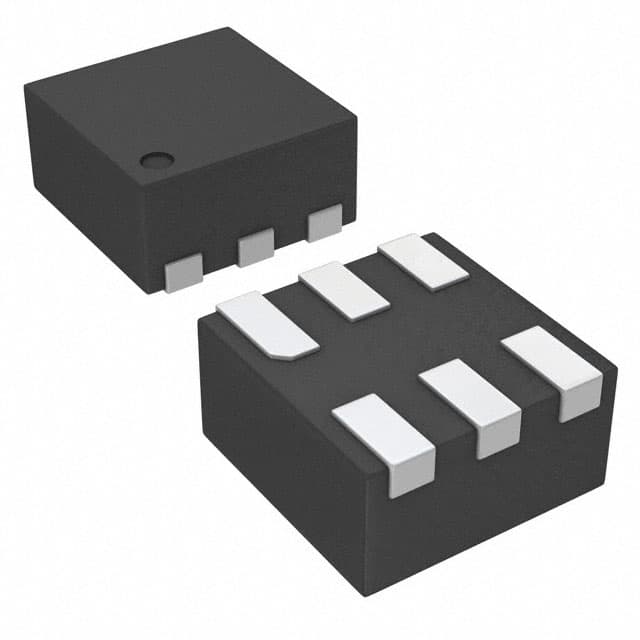Szczegóły produktu można znaleźć w specyfikacjach.

TPS610987DSET
Product Overview
Category: Integrated Circuit (IC)
Use: Voltage Boost Converter
Characteristics: - High efficiency voltage conversion - Wide input voltage range - Adjustable output voltage - Low quiescent current - Over-temperature protection - Short-circuit protection
Package: DSE (8-Pin WSON)
Essence: The TPS610987DSET is a voltage boost converter IC designed to efficiently step up the input voltage to a higher output voltage. It is commonly used in various electronic devices where a higher voltage level is required.
Packaging/Quantity: The TPS610987DSET is available in a 8-pin WSON package. It is typically sold in reels containing multiple units.
Specifications
- Input Voltage Range: 2.5V to 12V
- Output Voltage Range: 4V to 24V
- Switching Frequency: 1.2MHz
- Quiescent Current: 30µA
- Operating Temperature Range: -40°C to 85°C
Pin Configuration
The TPS610987DSET has the following pin configuration:
- EN (Enable): Enable pin for turning the boost converter on/off.
- FB (Feedback): Feedback pin for adjusting the output voltage.
- VIN (Input Voltage): Input voltage supply pin.
- SW (Switch Node): Switch node connection for the internal power switch.
- PGND (Power Ground): Power ground connection.
- LX (Inductor Connection): Connection to the external inductor.
- VOUT (Output Voltage): Output voltage connection.
- AGND (Analog Ground): Analog ground connection.
Functional Features
- High Efficiency: The TPS610987DSET offers high efficiency voltage conversion, minimizing power loss during the boosting process.
- Wide Input Voltage Range: It can accept input voltages ranging from 2.5V to 12V, providing flexibility in various applications.
- Adjustable Output Voltage: The output voltage can be adjusted within the range of 4V to 24V, allowing customization based on specific requirements.
- Low Quiescent Current: The IC has a low quiescent current of only 30µA, reducing power consumption during standby or idle modes.
- Over-Temperature Protection: The TPS610987DSET incorporates over-temperature protection, safeguarding the device from excessive heat.
- Short-Circuit Protection: It also features short-circuit protection, preventing damage in case of a short circuit.
Advantages and Disadvantages
Advantages: - High efficiency conversion - Wide input voltage range - Adjustable output voltage - Low quiescent current - Over-temperature and short-circuit protection
Disadvantages: - Limited maximum output voltage (up to 24V) - Requires an external inductor for operation
Working Principles
The TPS610987DSET operates as a boost converter, utilizing an internal power switch to step up the input voltage to a higher output voltage. When enabled, the IC controls the switching of the internal power switch at a high frequency, converting the input voltage into a series of pulses. These pulses are then filtered and smoothed to provide a stable output voltage.
Detailed Application Field Plans
The TPS610987DSET finds applications in various electronic devices and systems, including but not limited to: 1. Battery-powered devices requiring higher voltage levels, such as portable audio players and handheld gaming consoles. 2. LED backlighting systems in LCD displays, where a higher voltage is needed to drive the LEDs efficiently. 3. Power supply modules for IoT devices, enabling efficient voltage conversion for extended battery life.
Detailed and Complete Alternative Models
- TPS61098DSET: Similar to TPS610987DSET, but with a different pin configuration.
- TPS61165DSET: Boost converter IC with higher maximum output voltage and additional features.
- TPS61220DCKR: Step-up converter IC with adjustable output voltage and low quiescent current.
These alternative models offer similar functionality and can be considered as alternatives to the TPS610987DSET based on specific requirements and design constraints.
Word count: 511 words
Wymień 10 typowych pytań i odpowiedzi związanych z zastosowaniem TPS610987DSET w rozwiązaniach technicznych
Sure! Here are 10 common questions and answers related to the application of TPS610987DSET in technical solutions:
Q: What is TPS610987DSET? A: TPS610987DSET is a boost converter integrated circuit (IC) that provides a regulated output voltage from a lower input voltage.
Q: What is the input voltage range for TPS610987DSET? A: The input voltage range for TPS610987DSET is typically between 0.9V and 5.5V.
Q: What is the output voltage range for TPS610987DSET? A: The output voltage range for TPS610987DSET can be adjusted from 1.8V to 5.25V using external resistors.
Q: What is the maximum output current of TPS610987DSET? A: The maximum output current of TPS610987DSET is typically 1A, but it can vary depending on the input and output voltage levels.
Q: Can TPS610987DSET operate with a single lithium-ion battery? A: Yes, TPS610987DSET can operate with a single lithium-ion battery as long as the input voltage is within the specified range.
Q: Does TPS610987DSET have built-in protection features? A: Yes, TPS610987DSET has built-in protection features such as overvoltage protection, thermal shutdown, and short-circuit protection.
Q: Can TPS610987DSET be used in portable electronic devices? A: Yes, TPS610987DSET is commonly used in portable electronic devices like smartphones, tablets, and wearable devices.
Q: Is TPS610987DSET suitable for low-power applications? A: Yes, TPS610987DSET is suitable for low-power applications as it has a low quiescent current and high efficiency.
Q: Can TPS610987DSET be used in automotive applications? A: Yes, TPS610987DSET can be used in automotive applications as it meets the necessary requirements for automotive electronics.
Q: Are there any evaluation boards available for TPS610987DSET? A: Yes, Texas Instruments provides evaluation boards for TPS610987DSET, which can help in testing and prototyping applications.
Please note that these answers are general and may vary depending on specific application requirements and datasheet specifications.

